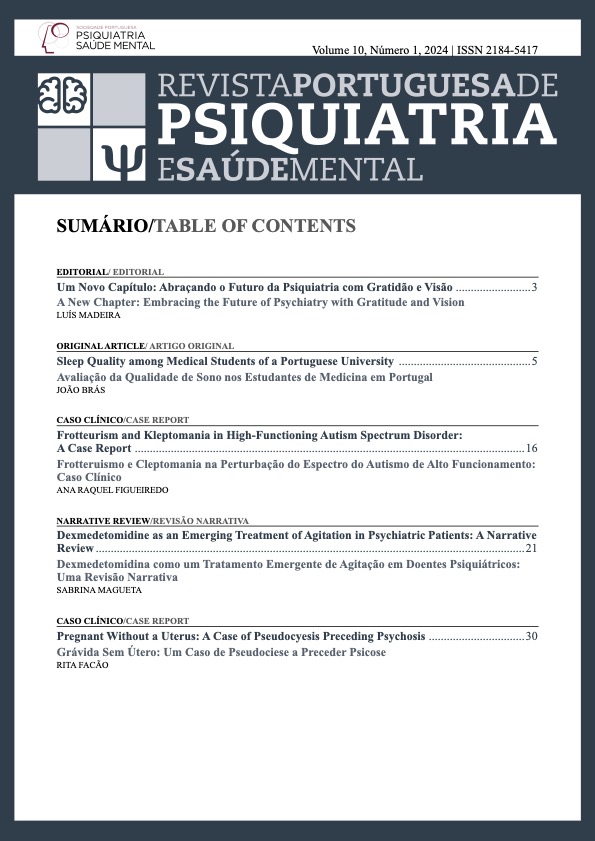Avaliação da Qualidade de Sono nos Estudantes de Medicina em Portugal
DOI:
https://doi.org/10.51338/rppsm.496Palavras-chave:
Distúrbios do Início e da Manutenção do Sono, Estudantes de Medicina, Inquéritos e Questionários, Perturbações do Sono, Qualidade de SonoResumo
Introdução: O sono é um processo fisiológico complexo presente na maioria dos seres vivos. As perturbações do sono têm vindo a aumentar exponencialmente. Os estudantes universitários, particularmente, os estudantes de medicina, são especialmente vulneráveis a esta problemática. Contudo, a literatura existente relativa ao tema é escassa, especialmente, em Portugal. O objetivo deste estudo consiste em avaliar a qualidade de sono nos estudantes do curso Medicina da Universidade da Beira Interior, Covilhã, Portugal e analisar as diferenças e relações existentes de acordo com a idade, sexo, coabitação e ano de curso.Métodos: Trata-se de um estudo transversal em que os estudantes envolvidos preencheram o Índice da Qualidade de Sono de Pittsburg (PSQI), previamente validado para a população portuguesa. Os valores obtidos, para cada componente do PSQI, foram inicialmente analisados para a população global, e posteriormente relacionados com as variáveis sociodemográficas, visando a obtenção de relações estatisticamente significativas.
Resultados: Duzentos noventa seis estudantes responderam ao questionário. Destes, 62,2% consideraram o seu sono bom; 42,4% obtiveram 1 na componente latência do sono; 50% admitiu dormir entre 6 a 7 horas; 73,9% evidenciou uma eficiência de sono adequada; 85,5% relatou pouco ou nenhum distúrbio do sono; 83,8% referiu nunca ter usado medicação para dormir; e 60,8% mencionou pouca ou nenhuma disfunção diurna. Relativamente ao PSQI global, 73,1% dos estudantes obtiveram uma pontuação superior a 5, indicando uma má qualidade de sono. Das raparigas, 74,7% e dos rapazes, 67,7% revelaram uma pobre qualidade de sono. Dos estudantes, que vivem sozinhos, 91,3% também exibiram uma pobre qualidade de sono. Relativamente ao ano letivo do curso no qual o inquérito foi aplicado, 82,4% dos estudantes do 1o ano reportaram uma pobre qualidade de sono, assim como 77,5% do 2o ano, 72,1% do 3o, 77,8% do 4o, 65,8% do 5o e 71,4% do 6o ano do curso.
Conclusão: Globalmente, os estudantes que participaram neste estudo apresentaram má qualidade de sono, com uma classificação no PSQI superior 5. Contudo, as classificações em cada um dos componentes não são tão negativas. A maioria dos participantes classificam o seu sono como bom ou muito bom, quase metade dos participantes referiram dormir mais de 7 horas e a maioria apresentou uma eficiência de sono superior a 85%. De igual forma, 83,8% nunca usaram medicação para dormir. Não sendo um resultado robusto, torna-se imperioso a realização de mais estudos que o comprovem inequivocamente. Mais, tais estudos também serão imprescindíveis para identificar situações em que a intervenção terapêutica melhorará tais parâmetros.
Downloads
Referências
Schwartz WJ, Klerman EB. Circadian Neurobiology and the Physiologic Regulation of Sleep and Wakefulness. Neurol Clin. 2019;37:475–86. doi: 10.1016/j. ncl.2019.03.001
Falup Pecurariu C, Diaconu Ștefania, Țînț D, Falup Pecurariu O. Neurobiology of sleep (Review). Exp Ther Med. 2021;21:272. doi: 10.3892/etm.2021.9703
Saper CB. The Neurobiology of Sleep. CONTINUUM. 2013;19:19–31. doi: 10.1212/01. CON.0000427215.07715.73
Rosenwasser AM, Turek FW. Neurobiology of Circadian Rhythm Regulation. Sleep Med Clin. 2015;10:403–12. doi: 10.1016/j.jsmc.2015.08.003.
Borbély AA, Daan S, Wirz-Justice A, Deboer T. The two-process model of sleep regulation: A reappraisal. J Sleep Res. 2016;25:131–43. doi: 10.1111/jsr.12371.
Trachsel L, Edgar DM, Seidel WF, Craig Heller H. Sleep homeostasis in suprachiasmatic nuclei-lesioned rats: effects of sleep deprivation and triazolam administration. Brain Res. 1992;589:253–61. doi: 10.1016/00068993(92)91284-l.
Troynikov O, Watson CG, Nawaz N. Sleep environments and sleep physiology: A review. J Thermal Biol. 2018;78:192–203. doi: 10.1016/j. jtherbio.2018.09.012.
Albqoor MA, Shaheen AM. Sleep quality, sleep latency, and sleep duration: a national comparative study of university students in Jordan. Sleep Breath. 2021;25:1147–54. doi: 10.1007/s11325-020-02188-w.
Caddick ZA, Gregory K, Arsintescu L, Flynn-Evans EE. A review of the environmental parameters necessary for an optimal sleep environment. Build Environ. 2018;132:11–20. doi: 10.1016/j.buildenv.2018.01.020
Troynikov O, Watson CG, Nawaz N. Sleep environments and sleep physiology: A review. J Sleep Quality among Medical Students of a Portuguese University Therm Biol. 2018;78:192–203. doi: 10.1016/j.jtherbio.2018.09.012.
le Bon O. Relationships between REM and NREM inv the NREM-REM sleep cycle: a review on competing concepts. Sleep Med. 2020;70:6–16. doi: 10.1016/j. sleep.2020.02.004.
Brinkman JE, Reddy V, Sharma S. Physiology of Sleep [Internet]. In: StatPearls. Treasure Island: StatPearls Publishing; 2022 Jan [cited 2022 Oct 10]. Available from: https://www.ncbi.nlm.nih.gov/books/ NBK482512/.
Carley DW, Farabi SS. Physiology of Sleep. Diabetes Spectrum. 2016;29:5–9. doi: 10.2337/diaspect.29.1.5.
Paiva T, Penzel T. Centro de Medicina do Sono. Lisboa: Lidel; 2011.
Krueger JM, Frank MG, Wisor JP, Roy S. Sleep function: Toward elucidating an enigma. Sleep Med Rev. 2016;28:46–54. doi: 10.1016/j.smrv.2015.08.005.
Christova M, Aftenberger H, Nardone R, Gallasch E. Adult Gross Motor Learning and Sleep: Is There a Mutual Benefit? Neural Plasticity. 2018 :2018:3076986. doi: 10.1155/2018/3076986.
Assefa SZ, Diaz-Abad M, Wickwire EM, Scharf SM. The Functions of Sleep. AIMS Neurosci. 2015;2:155–1. doi: 10.3934/Neuroscience.2015.3.155
Gonçalves M, Peralta AR, Monteiro Ferreira J, Guilleminault C. Sleepiness and motor vehicle crashes in a representative sample of Portuguese drivers: the importance of epidemiological representative surveys. Traffic Inj Prev. 2015;16:677–83. doi: 10.1080/15389588.2015.1013535.
Gonçalves M, Amici R, Lucas R, Åkerstedt T, Cirignotta F, Horne J, et al. Sleepiness at the wheel across Europe: a survey of 19 countries. J Sleep Res. 2015;24:242–53. doi: 10.1111/jsr.12267.
Samouco AI, Almeida B, Soares CL, Machado C, Fragoeiro C, Caetano F, et al. A Ciência do Sono. Lisboa: Parsifal; 2020.
Krueger JM, Rector DM, Roy S, van Dongen HPA, Belenky G, Panksepp J. Sleep as a fundamental property of neuronal assemblies. Nat Rev Neurosci. 2008;9:910–9. doi: 10.1038/nrn2521.
Liu T, Jiang CY, Fujita T, Luo SW, Kumamoto E. Enhancement by interleukin‐ 1β of AMPA and NMDA receptor‐mediated currents in adult rat spinal superficial dorsal horn neurons. Mol Pain. 2013;9:1744-8069-9–16. doi: 10.1186/1744-8069-9-16.
Churchill L, Rector DM, Yasuda K, Fix C, Rojas MJ, Yasuda T, et al. Tumor necrosis factor α: Activity dependent expression and promotion of cortical column sleep in rats. Neuroscience. 2008;156:71–80. doi: 10.1016/j.neuroscience.2008.06.066.
De A, Krueger JM, Simasko SM. Tumor necrosis factor α increases cytosolic calcium responses to AMPA and KCl in primary cultures of rat hippocampal neurons. Brain Res. 2003;981:133–42. doi: 10.1016/ s00068993(03)02997-4.
Al-Khani AM, Sarhandi MI, Zaghloul MS, Ewid M, Saquib N. A cross-sectional survey on sleep quality, mental health, and academic performance among medical students in Saudi Arabia. BMC Res Notes. 2019;12:665. doi: 10.1186/s13104-019-4713-2.
Mohammadbeigi A, Absari R, Valizadeh F, Saadati M, Sharifimoghadam S, Ahmadi A, et al. Sleep Quality in Medical Students; the Impact of Over-Use of Mobile Cell-Phone and Social Networks. J Res Health Sci. 2016;16:46-50.
Blanco C, Okuda M, Wright C, Hasin DS, Grant BF, Liu SM, et al. Mental health of college students and their non-college-attending peers: Results from the national epidemiologic study on alcohol and related conditions. Arch Gen Psychiatry. 2008;65:1429–37. doi: 10.1001/archpsyc.65.12.1429
Wang F, Bíró É. Determinants of sleep quality in college students: A literature review. EXPLORE. 2021;17:170–7.
Gomes A, Tavares J, Pinto de Azevedo MH. Padrões de sono em estudantes universitários portugueses. Acta Med Port. 2009;22:545-52. doi: 10.1016/j. explore.2020.11.003.
Reis M, Ramiro L, Paiva T, Gaspar-de-Matos M. National Survey on the importance of sleep in the quality of academic life and mental health of college students in Portugal. Sleep Sci. 2021;14: 125-132. doi: 10.5935/1984-0063.20200090.
Azad MC, Fraser K, Rumana N, Abdullah AF, Shahana N, Hanly PJ, et al. Sleep Disturbances among Medical Students: A Global Perspective. J Clin Sleep Med. 2015;11:69–74. doi: 10.5664/jcsm.4370.
Jahrami H, Dewald-Kaufmann J, Faris MA, AlAnsari AM, Taha M, et al. Prevalence of sleep problems among medical students: a systematic review and meta-analysis. J Public Health. 2020; 28, 605-22. doi: 10.1007/s10389-019-01064-6
Alsaggaf MA, Wali SO, Merdad RA, Merdad LA. Sleep quantity, quality, and insomnia symptoms of medical students during clinical years. Saudi Med J. 2016;37:173–82. doi: 10.15537/smj.2016.2.14288.
Ahrberg K, Dresler M, Niedermaier S, Steiger A, Genzel L. The interaction between sleep quality and academic performance. J Psychiatr Res. 2012;46:1618–22. doi: 10.1016/j.jpsychires.2012.09.008.
Gardani M, Bradford DRR, Russell K, Allan S, Beattie L, Ellis JG, et al. A systematic review and meta-analysis of poor sleep, insomnia symptoms and stress in undergraduate students. Sleep Med Rev. 2022;61:101565. doi: 10.1016/j.smrv.2021.101565.
Rathakrishnan B, Singh SS, Kamaluddin MR, Yahaya A, Nasir MA, Ibrahim F, et al. Smartphone addiction and sleep quality on academic performance of university students: An exploratory research. Int J Environ Res Public Health. 2021;18. doi: 10.3390/ ijerph18168291.
Zhong Y, Ma H, Liang YF, Liao CJ, Zhang CC, Jiang WJ. Prevalence of smartphone addiction among Asian medical students: A meta-analysis of multinational observational studies. Int J Soc Psychiatry. 2022;68:117183. doi: 10.1177/00207640221089535.
Buysse DJ, Reynolds CF 3rd, Monk TH, Berman SR, Kupfer DJ. The Pittsburgh Sleep Quality Index: a new instrument for psychiatric practice and research. Psychiatry Res. 1989;28:193-213. doi: 10.1016/01651781(89)90047-4.
Del Rio JK, Becker NB, de Neves Jesus S, Santos Martins IR. Validation of the Portuguese version of the Pittsburgh Sleep Quality Index (PSQI-PT). Psychiatry Res. 2017;247:225-9. doi: 10.1016/j. psychres.2016.11.042.
Angerer P, Schmook R, Elfantel I, Li J. Night Work and the Risk of Depression. Dtsch Arztebl Int. 2017;114:404-11. doi: 10.3238/arztebl.2017.0404.
Pavlova M, Latreille V. Sleep disorders. Am J Med. 2019;132:292–9. doi: 10.1016/j.amjmed.2018.09.021.
Reis C, Dias S, Rodrigues AM, Sousa RD, Gregório MJ, Branco J, et al. Sleep duration, lifestyles and chronic diseases: A cross-sectional population-based study. Sleep Sci. 2018;11:217–30. doi: 10.5935/19840063.20180036.
Gaultney JF. The prevalence of sleep disorders in college students: impact on academic performance. J Am Coll Health. 2010;59:91–7. doi: 10.1080/07448481.2010.483708.
Corrêa CC, Oliveira FK, Pizzamiglio DS, Ortolan EV, Weber SA. Sleep quality in medical students: a comparison across the various phases of the medical course. J Bras Pneumol. 2017;43:285-9. doi: 10.1590/ S180637562016000000178.
Gupta S, Bhardwaj A, Nadda A, Gill A, Mittal A, Gupta S. A comparative study of sleep quality in different phases of the medical course: A study from Haryana (North India). J Family Med Prim Care. 2020;9:2006. doi: 10.4103/jfmpc.jfmpc_1137_19.
46. Sweileh WM, Ali IA, Sawalha AF, Abu-Taha AS, Zyoud SH, Al-Jabi SW. Sleep habits and sleep problems among Palestinian students. Child Adolesc Psychiatry Ment Health. 2011;5:25. doi: 10.1186/1753-2000-5-25.
Lemma S, Patel SV, Tarekegn YA, Tadesse MG, Berhane Y, Gelaye B, et al. The Epidemiology of Sleep Quality, Sleep Patterns, Consumption of Caffeinated Beverages, and Khat Use among Ethiopian College Students. Sleep Disord. 2012;2012:583510. doi: 10.1155/2012/583510.
Lund HG, Reider BD, Whiting AB, Prichard JR. Sleep patterns and predictors of disturbed sleep in a large population of college students. J Adolesc Health. 2010;46:124–32. doi: 10.1016/j. jadohealth.2009.06.016.
Al-Sayed AA, Al-Rashoudi AH, Al-Eisa AA, Addar AM, Al-Hargan AH, AlJerian AA, et al. Sedative Drug Use among King Saud University Medical Students: A Cross-Sectional Sampling Study. Depress Res Treat. 2014;2014:1–7. doi: 10.1155/2014/378738.
Rique GL, Fernandes Filho GM, Ferreira AD, de Sousa-Muñoz RL. Relationship between chronotype and quality of sleep in medical students at the Federal University of Paraiba, Brazil. Sleep Sci. 2014;7:961. doi: 10.1016/j.slsci.2014.09.004.
Sundas N, Ghimire S, Bhusal S, Pandey R, Rana K, Dixit H. Sleep quality among medical students of a tertiary care hospital: a descriptive crosssectional study. J Nepal Med Assoc. 2020;58:222. doi: 10.31729/ jnma.4813.
Suh S, Cho N, Zhang J. Sex Differences in insomnia: from epidemiology and etiology to intervention. Curr Psychiatry Rep. 2018;20:69. doi: 10.1007/ s11920-018-0940-9.
Amaral AP, Bos SC, Soares MJ, Pereira AT, Marques M, Madeira N, et al. Personality, cognitive emotion regulation and insomnia. Arch Clin Psychiatry. 2021;48: 29-35. doi: 10.1590/0101-60830000000275
Riemann D, Krone LB, Wulff K, Nissen C. Sleep, insomnia, and depression. Neuropsychopharmacology. 2020;45:74-89. doi: 10.1038/s41386-0190411-y.








